On the topic of tourist taboos, the late British journalist A.A. Gill once noted that “every camel owner has heard every Lawrence of Arabia quote and none of them have seen the film.”
So, despite temptation, I refrain.
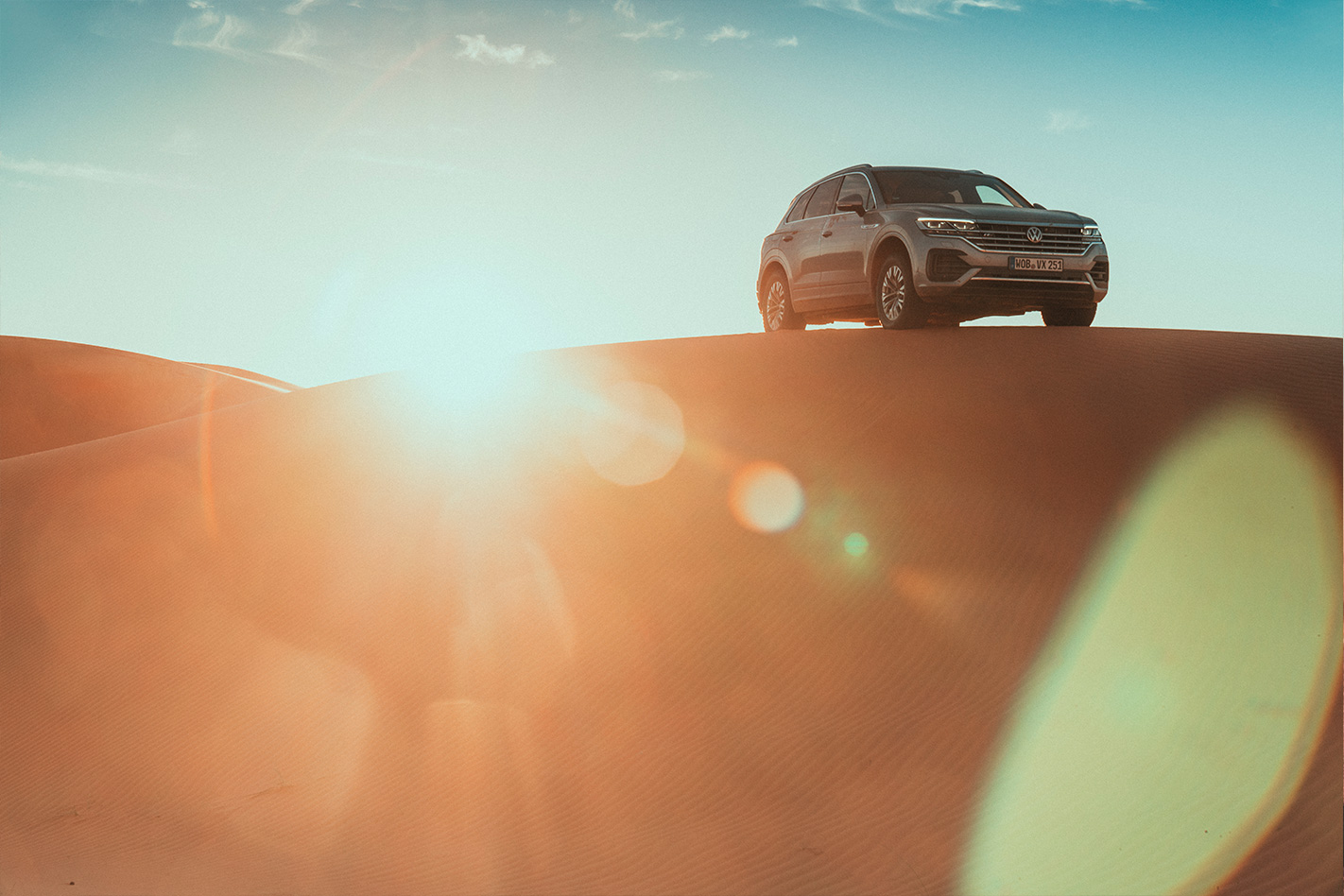
Because in Morocco this is likely true, with tourists flocking here to live out their Maghreb dreams of amber Saharan sunsets on the back of one-humped ungulates, many of which are Australian-born and exported here.
Alas, our ride, despite sharing a name with one of the local nomad tribes, is not a native of this land. But if ever there was a proving ground to help shake off any sleepy suburban associations the Volkswagen Touareg might have, it is four days spent exploring the sprawling, challenging and diverse landscape of this North African wilderness.
It’s been eight years since Volkswagen graced us with a new Touareg. This third generation, unveiled in Beijing last year, is Wolfsburg’s most ambitious and luxurious SUV to date.
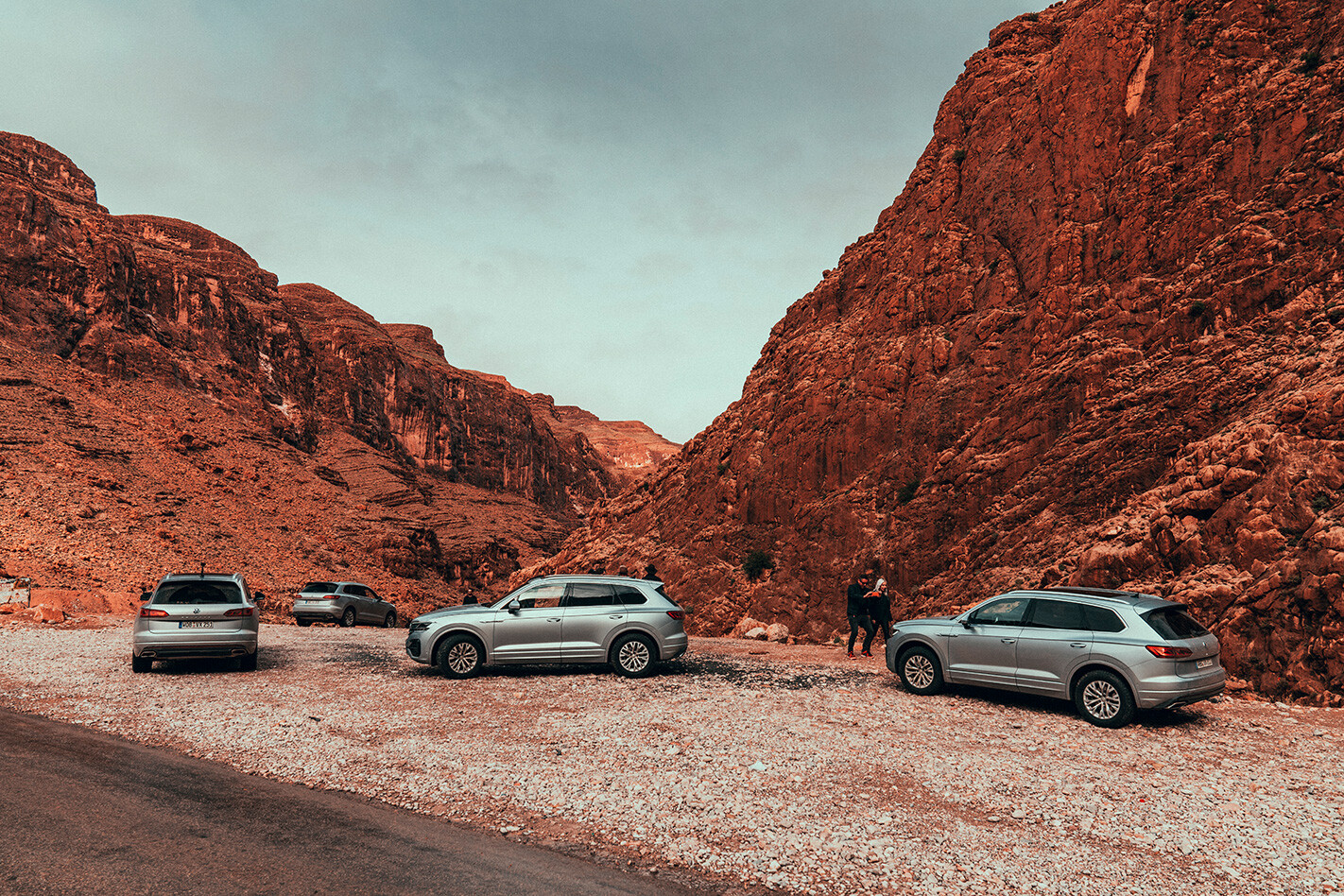
“Tailor-made, innovative, pure ability, pure muscle,” VW head of design Klaus Bischoff enthused at the time. “Never before has it been this elegant, this innovative.”
Sure, he would say that, but he does have a point. The all-new five-seater, underpinned by the group’s lauded MLB platform (shared by the Audi Q7, Bentley Bentayga, Porsche Cayenne and Lamborghini Urus), has arrived with a new level of sophistication, technology, and dare I say … beauty? So much so, Touareg is locking eyes with showroom frontrunners and luxury goliaths like the BMW X5, Audi Q7 and Volvo XC90. As for the muscle that Bischoff mentions? That remains to be flexed over the next four days in rural Morocco.

Our journey starts at the crack of dawn in Marrakesh, where the only thing more painful than the passport-control line at the airport is the deathly peak-hour traffic. With a rising crimson sun in the distance, we turn on the Desert-Storm-like Night Vision, one of the many driver-assistance systems making its debut in the Touareg, and embark on a 588km journey. Our destination is an eastern desert camp in Merzouga, which lies at the foot of the enormous Erg Chebbi sand dunes, just 50km from the notoriously shady Algerian-Morocco border.
Propped up on protuberant General Grabber 225/60 tyres on 18-inch alloys, our left-hook, high-spec R-line Touareg’s first challenge is the snaking and currently icy hill climb through the snow-capped Atlas Mountains.
In Australia, the Touareg will arrive with a 3.0-litre V6 turbo-diesel engine making 190kW and 550Nm; a unit already familiar to Amarok owners. However, our European-sourced test car boasts a mouse-quiet yet ballsier 210kW/600Nm tune that Australia won’t see until later this year. While other markets might get a V6 petrol, a plug-in-hybrid or even a burlier V8 turbo-diesel, none are yet confirmed for Oz.
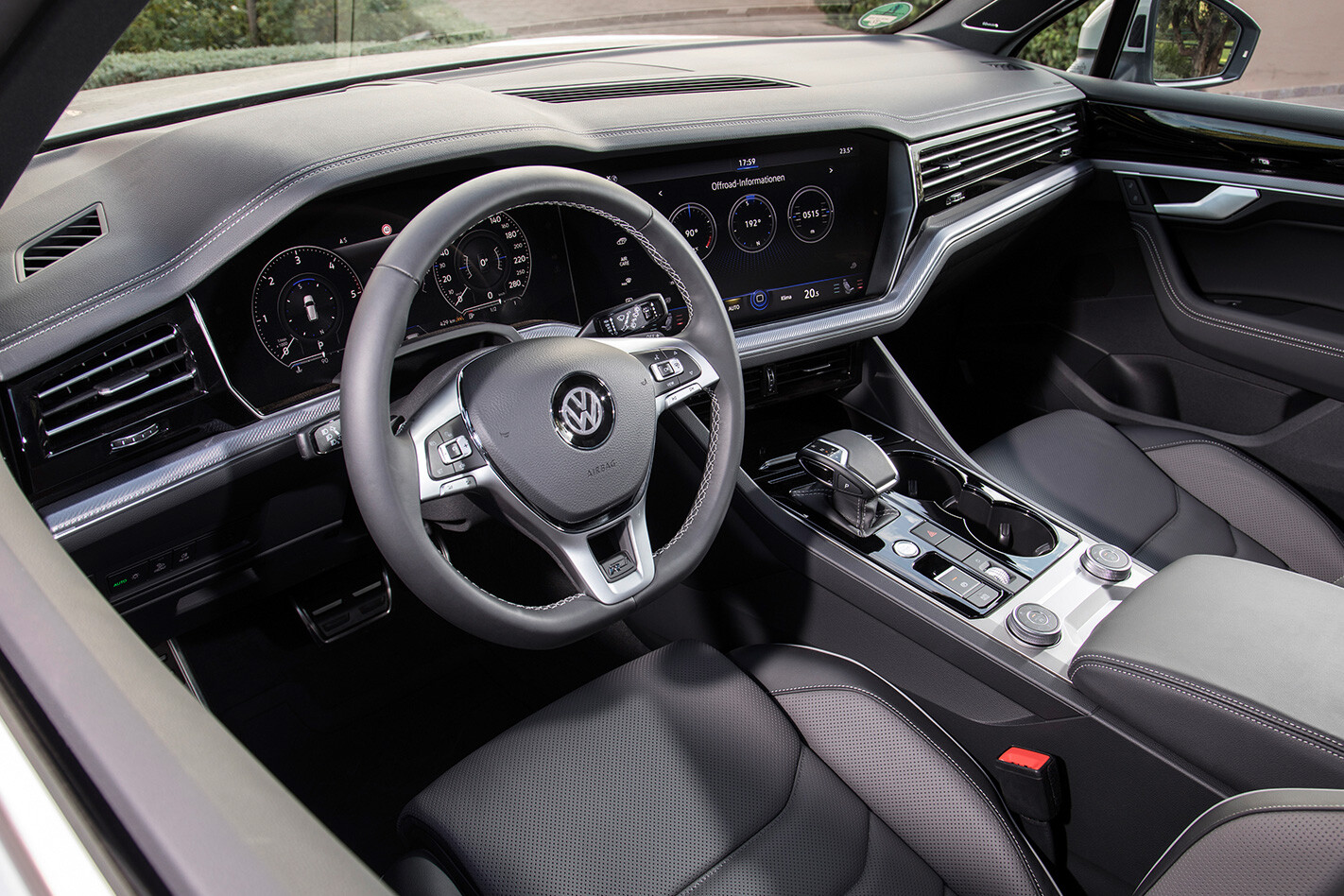
Our high-flying route turns out to be a mix of shockingly terrible and extraordinarily smooth roads, and blind cliff corners that put us at eye level with Golden Eagle nests. Our pedestrian-monitoring system is put to the test saving the tenuous lives of locals who leap onto the road in front of us to peddle shiny rocks.
The mountainous landscape shows off the hefty two-tonne SUV’s newfound nimbleness, which has been achieved in spite of the fact that it’s actually 83mm longer, 44mm wider and on a 1mm longer wheelbase than the old Touareg. Fortunately, it’s also lighter, and lower, than its predecessor. Adaptive air suspension and four-wheel steering contribute to a level of dexterity that is hard to fault, even in tough conditions.
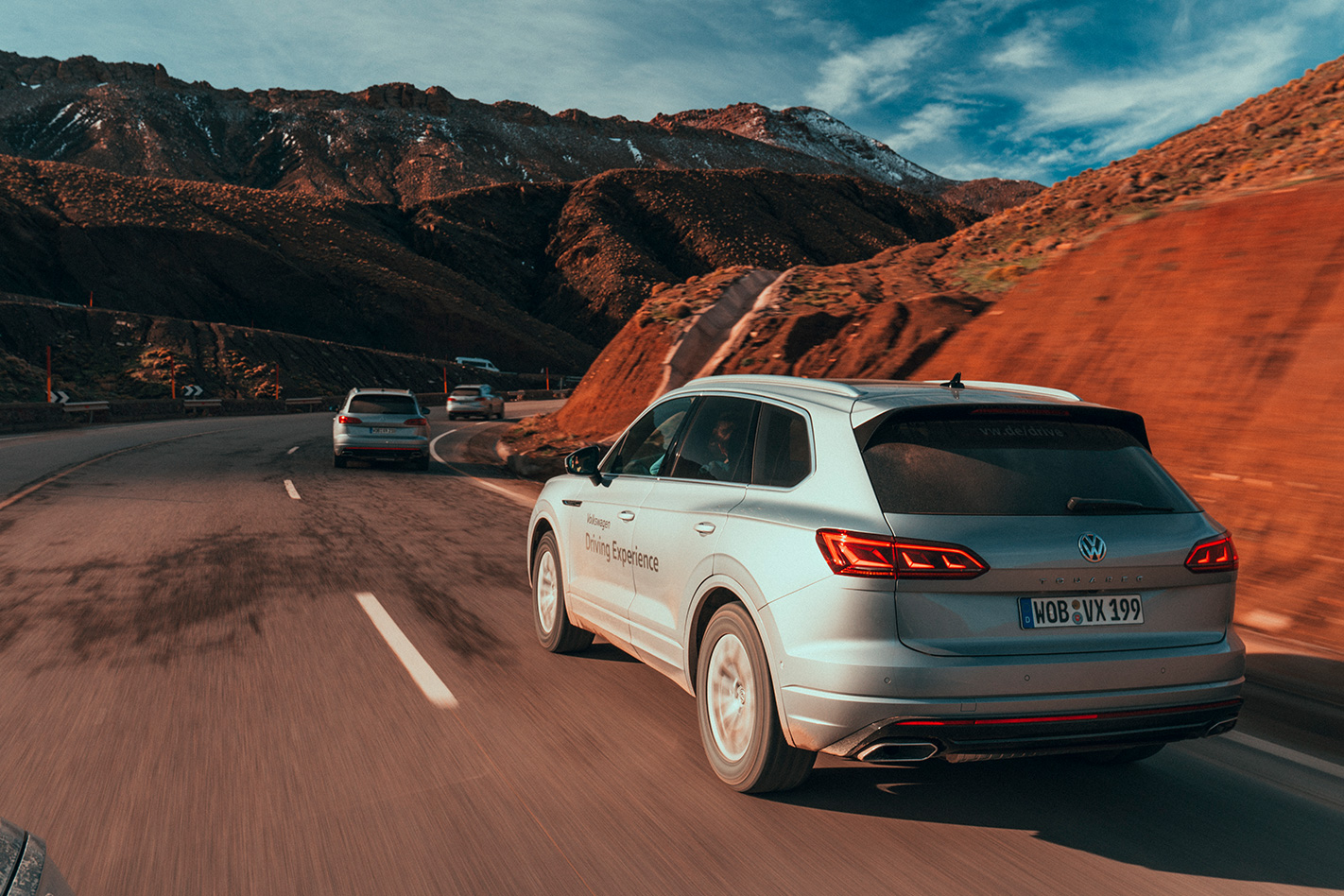
Couple this with the active anti-roll bars that we’ll be thankful for once we reach the dunes, and these are options sure to be worth their weight in gilded couscous.
After hours of majestic mountainscapes and towns of dreamy pastel-salmon-hued architecture, plus a Moroccan tea and coffee stop along the way, we arrive at the edge of the Sahara, where we’re greeted by a tawny sunset coated in a rich stillness. At this point, in the silence of our otherworldly desert camp, aside from the occasional camel, our only reminder of home is the odd Eucalyptus tree growing out of the dirt.
As we unpack the car, my co-driver notes the 9.0L/100km trip reading on our display. It’s far from the 6.0L/100km fuel consumption VW says the Touareg will give you in an urban environment, but still surprising considering the number of hill climbs and power-overtaking manoeuvres of donkey carts and beat-up Volkswagen Mk2s, Renault 4s and Mercedes-Benz W123s dressed as taxis we just performed. If you’re in the market for an old French hatch, Morocco is a dream; what old 4×4 Fiat Pandas are to rural Italy, the Renault 4 is to the Maghreb.
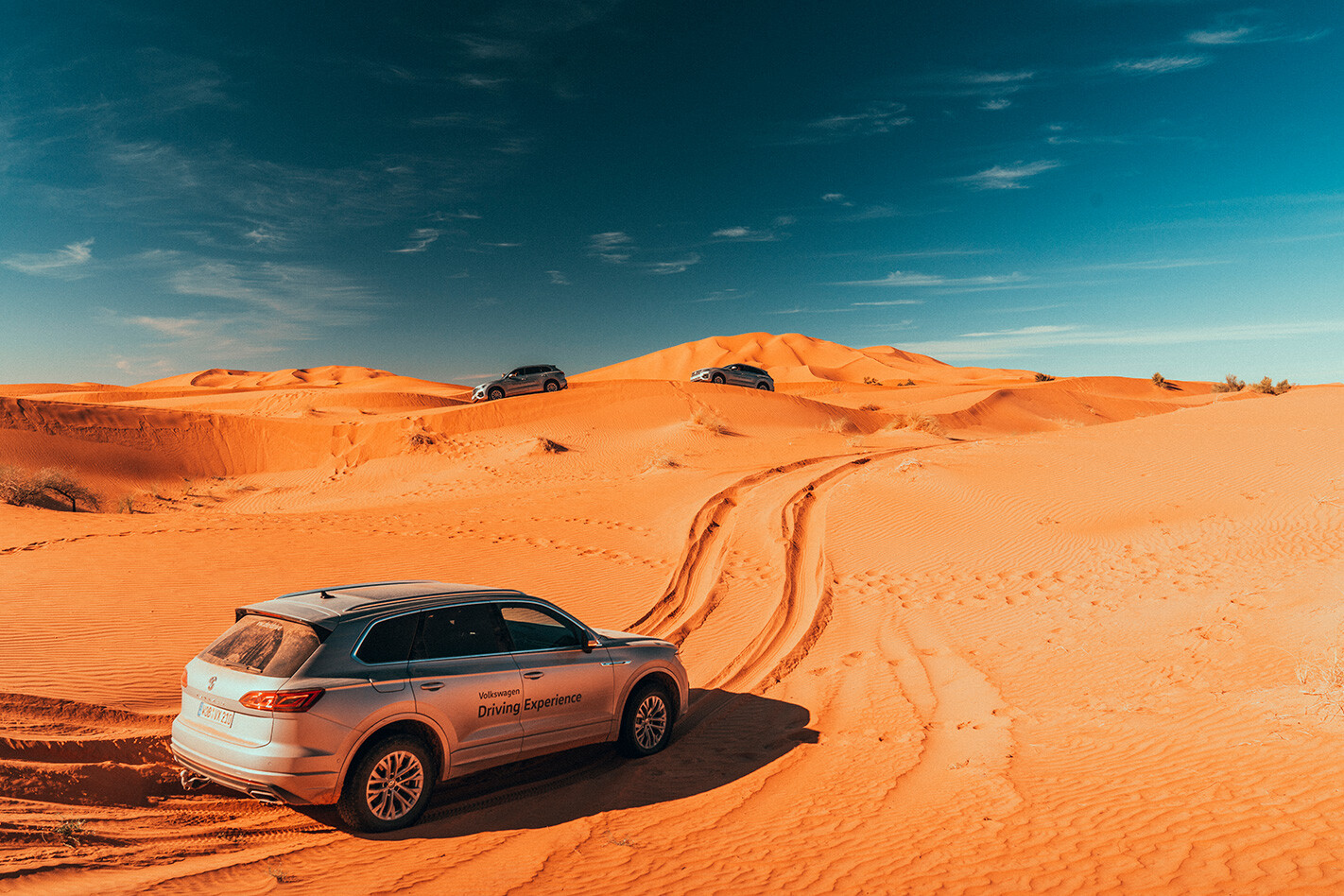
After a night under a bright, full desert moon peppered with campfire crackles and French-Arabic sing-alongs by our camp’s staff, we rise at dawn to prepare the Touaregs for a day tackling some of the largest dunes in the Sahara. In Erg Chebbi, some of these wind-formed structures can rise up to 150m tall. I’m told that, in summer, locals come here to bury themselves neck-deep as a cure for various ailments (presumably being dry-roasted alive by Saharan sand will make other illnesses seem trivial).
Before our Touaregs get coated in this dust-fine sand, I have a sniff around the boot, which has grown from 697L (1642L with rear seats flat) to 810L (1800L) and sample the glorious adult-sized space in the rear. Actually, it was more of a desperate attempt to get signal from our car’s always-on wi-fi hotspot. Using a SIM, up to eight devices can connect and, based on my testing, the signal stretches to up to five metres away. It’s great for camping, provided you’re not in the Sahara.
When it comes to technology, Volkswagen has certainly learned from the shortcomings of the previous-gen Touareg, which struggled to keep up with the times. Smugly driver-centric, highly user-friendly and cleanly designed, the Touareg packs so much in that it’s almost a smartphone itself. The huge, customisable 15-inch digital central touchscreen and seamless 12.3-inch Active Info display, (which, granted, will come at a price) is stunning and arguably rivalled only by Volvo’s current system.
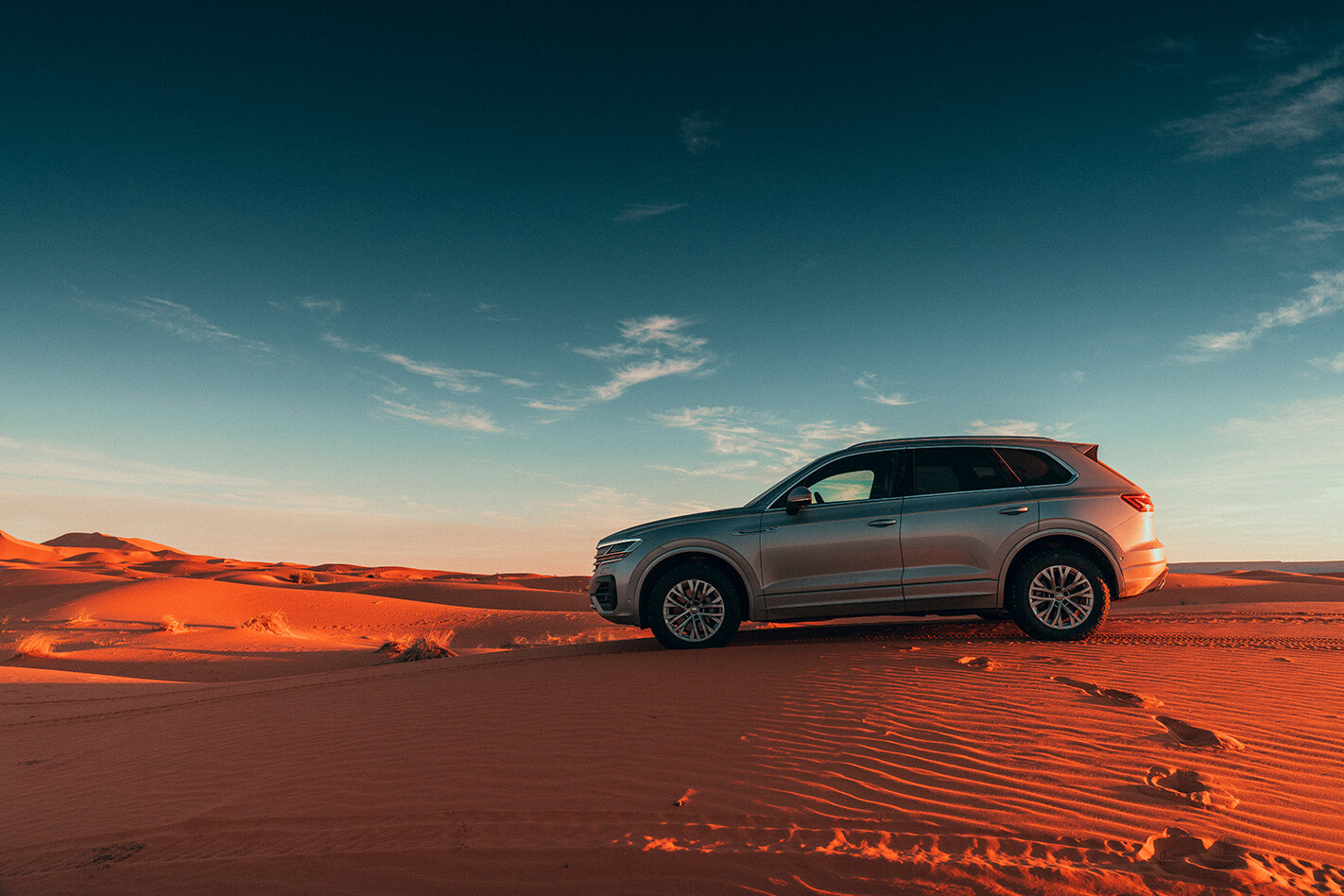
Keep in mind, our Touaregs had every box ticked, but with a 14-speaker 730-watt Dynaudio system (or 80W eight-speaker system as standard), four USB ports, wireless charging, a head-up display, as well as active safety including semi-automated steering and lane-keep assist, cross-traffic assist, LED matrix headlights, park assist (including trailer-manoeuvring assist), driver-fatigue-alert systems and active pre-crash systems; one can see why this is the most thought-through VW to date. And in eventual top-spec guise, likely one of the priciest.
The Germans in charge of our expedition have deactivated our enormous panoramic sunroof to minimise dune-hoon sand damage, which is probably for the best. After dropping tyre pressures and switching our driving mode to ‘Sand’, Dakar jokes are made and we’re taking on the baby dunes – which involves much use of the old “when in doubt, power out” mantra. And if you do get bogged, some tricky use of the same, only in reverse will generally save you.

At this point, I’m not sure if I’m having heart palpitations from the fun of it all, or because of the looming dunes I can see in our future. Bouncing over the ergs (as the locals call them) and carving up the fine Saharan sand, the sprightly Touareg feels a lot smaller than it is, with the V6 providing all the power needed. That is until our training wheels are taken off and we’re faced with a CGI-like wall of sand some 50-plus stories high. We’re told to go straight up. Don’t stop. Right foot flat. I’m second in line, driving alone and feeling smug so, of course, I bog the thing before the crest. Thankfully the Touareg has a towing capacity of 3.5 tonnes, so I’m pulled out by one of the identical VWs in our group.
I tap into everything I’ve learned from hours of watching Saudi Arabian dune racing on YouTube, and following the #justsendit hashtag on Instagram, and find myself in a blur of sand and sky and bumps and V6 growls. I’m hammering up the dunes pointing toward a German dot waving his arms at the top.
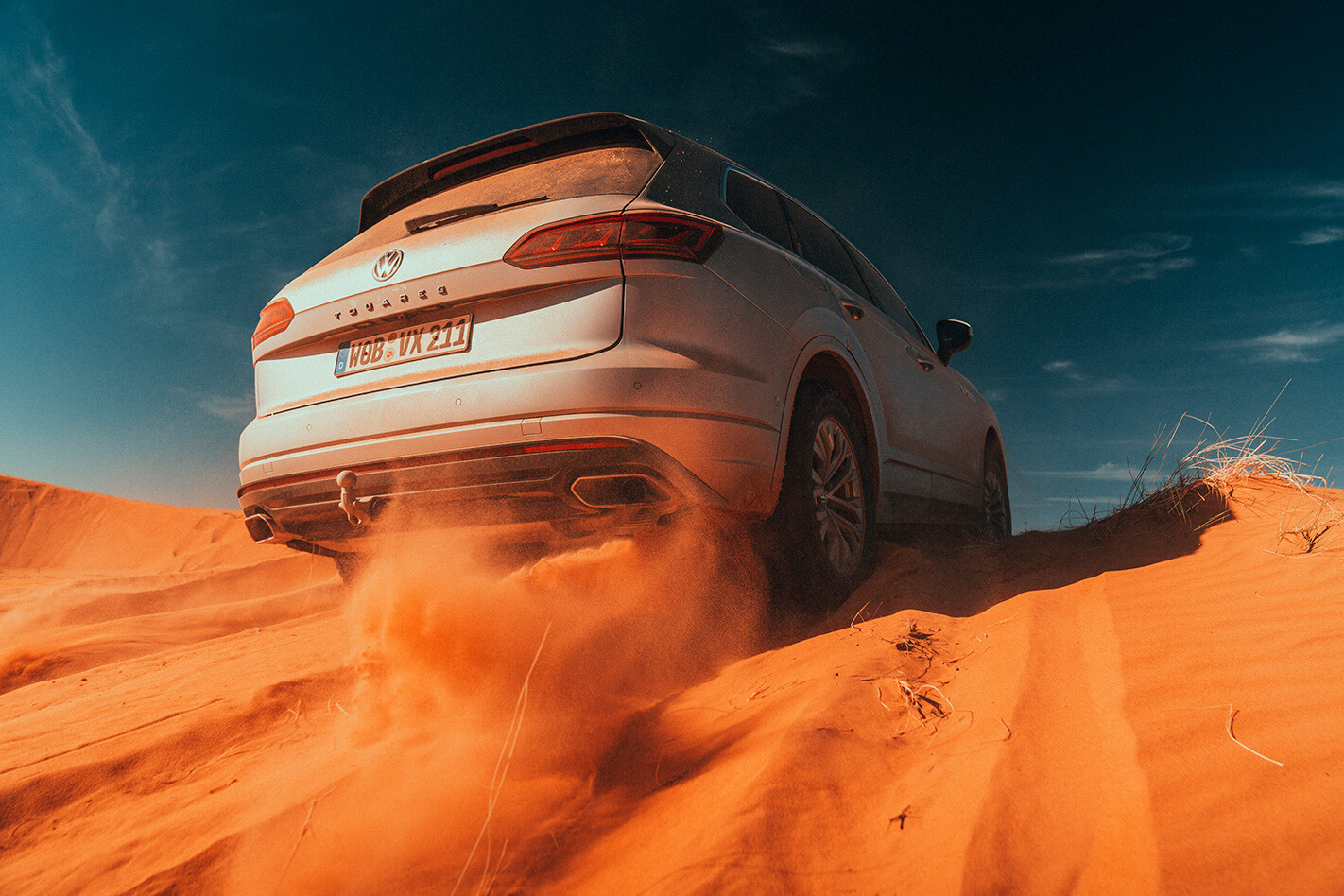
The view is breathtaking, extending toward Algeria and beyond. Our campsite is but a fuzzy oil painting below. Thing is, I spend way too much time taking in the view, and don’t realise everyone has already made their descent. So Chris Benny, our photographer, and I are alone on Erg Chebbi. I have no choice but to point the thing downwards and go for it. Alas, hill-descent kicks in – it’s auto-activated in off-road mode – and the entire experience feels like I’m on a wire. Easy.
Making our way out of the desert, our night is to be spent in a kasbah in Ksar Bicha. This is camel country, where drivers prepare their beautiful herds for sunset tours. As the sun falls, the serene call to prayer echoes across the small town of unfinished and decrepit buildings and, just outside my room, sleepy-eyed camels curl up for the night as a majestic ambience rings in the air. The next day, our loop back to Marrakech begins, this time with a lot less drama, or so we’re told.

We have just over 500km to go, including long stretches of highway, rain and mud, through the upper Dades Valley and its desert plateau. We pass through “gateways to the Sahara”; grand, regal-looking Moroccan gates that announce more peach-coloured towns filled with bustling bazaars and children stacked on motorbikes. You can imagine the statement seven silver Volkswagens, complete with mean modernist grilles and exaggerated arches, make upon arrival.
From the cockpit, these long stretches highlight the lounge-like quality of the Touareg’s interior. It also gives us time to play with the personalisation, including things like the ambient lighting, digital-cockpit set-up and home-screen preferences, as well as the driver-assistance systems, which do what they say on the tin, even if the lane-keep assist drives us a little mad.
The final leg, from the Dades Valley to Marrakesh, via Ouarzazate, is where the sheer generosity of the glasshouse and cabin visibility shines in the Touareg, at least in the front two seats. This is Morocco’s Hollywood, a famous backdrop to Lawrence of Arabia (of course), Gladiator, The Mummy and more. The tall, blocky towers of the ancient Ksar Aït Benhaddou hold court here, bookended by a geological rainbow of colour.
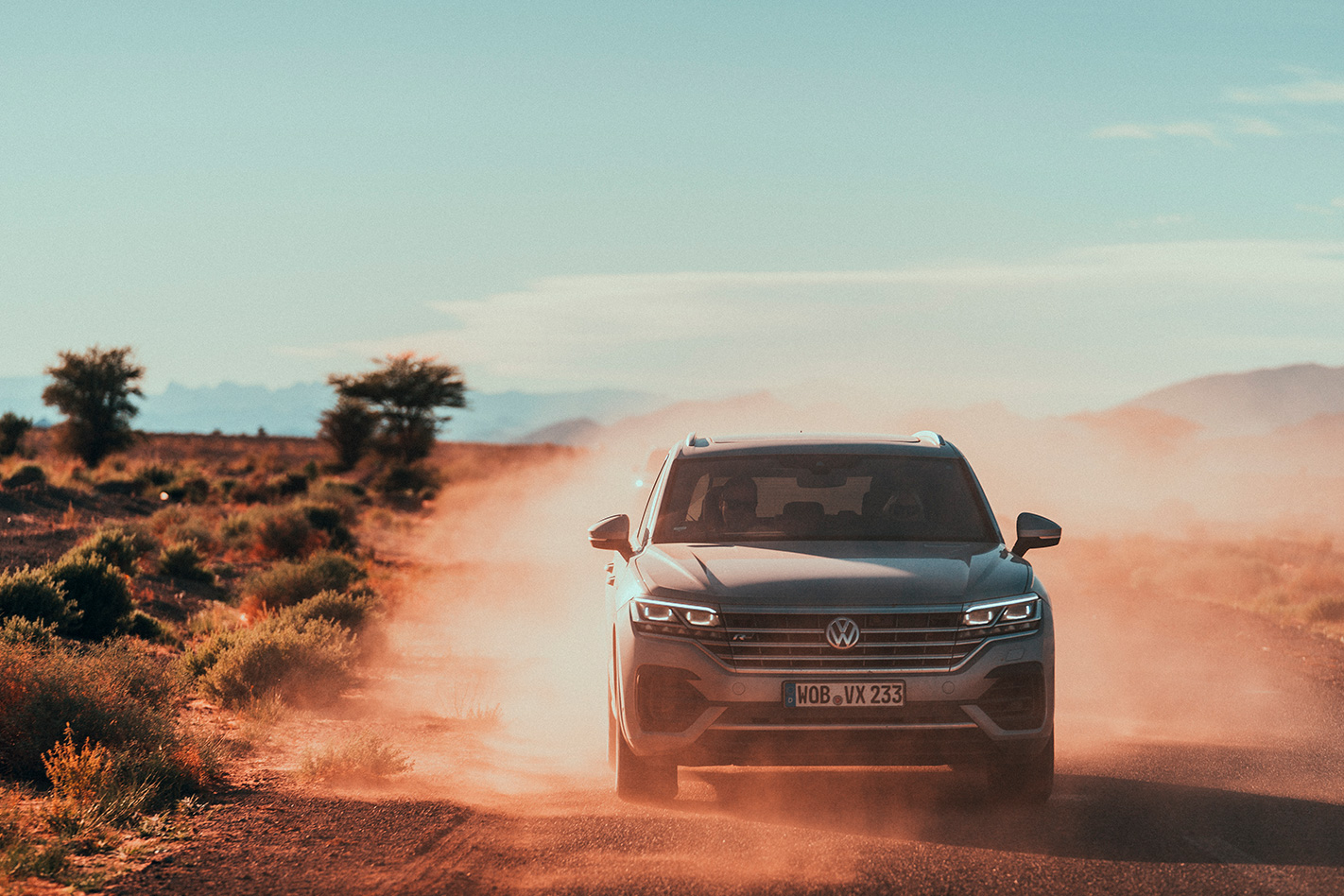
Our destination is the Draa Valley, a rocky riverbed and our final chance to put the Touareg to the test. After turning the dial to ‘Off-road, level two’, raising the height of the adaptive air suspension 70mm for a total clearance of 258mm, we’re guided by the careful Germans over boulders and streams to a road banked at 35 degrees. The Touareg doesn’t even flinch.
Then, with just over 100km to go, the Germans start to get edgy. Is it just that famous culture of punctuality, or something more? We soon find out that the problem is we’re heading for the Tizi n’Tichka Pass – a cliff-hugging twister that rises 2260m, back through the Atlas Mountains, part of which we took on day one – that is regarded as one of the most dangerous roads in the world. Couple that attention-grabbing reputation with the mania of Marrakesh during peak hour, and our hosts are itching to get back, preferably in one piece.
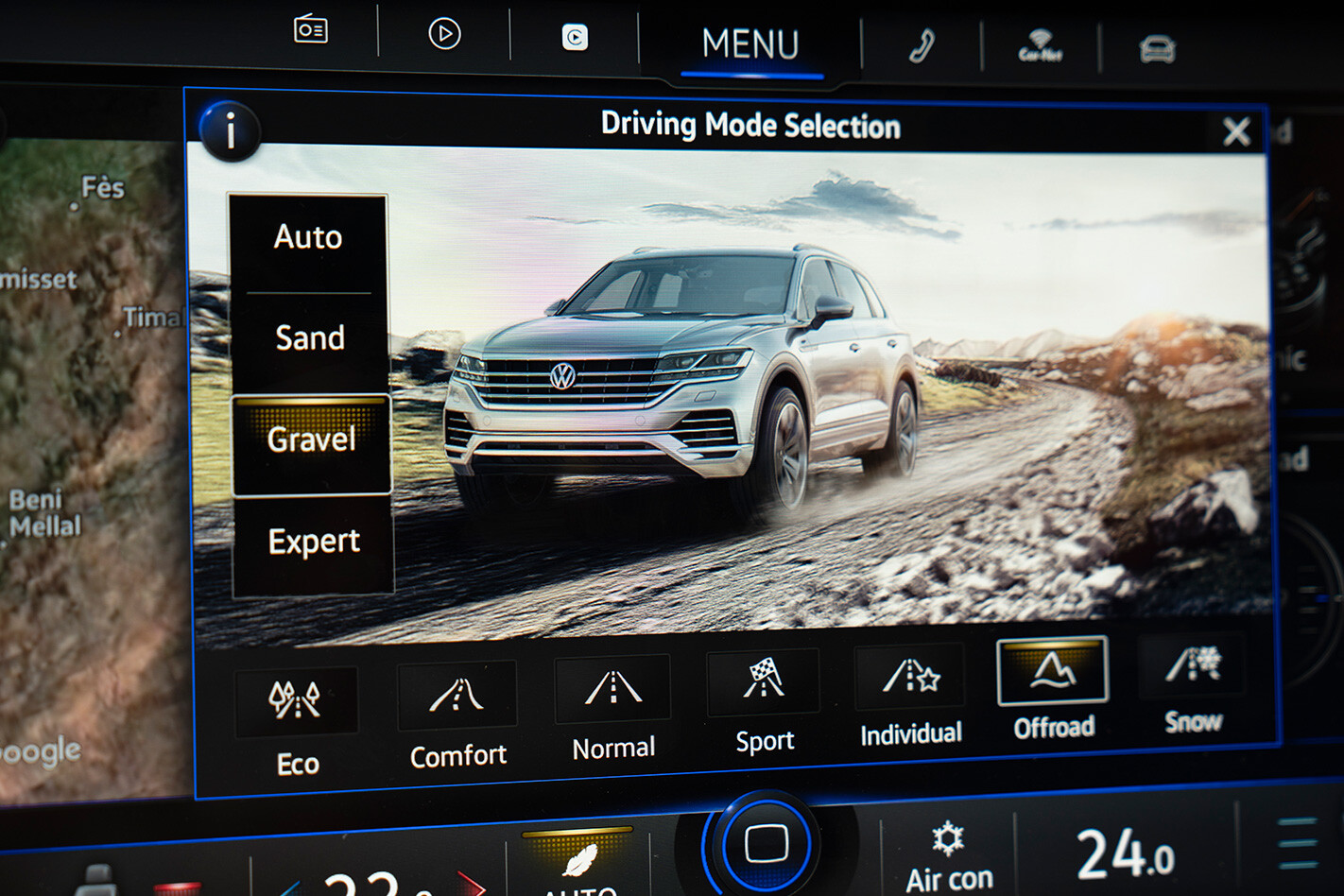
The drive home sees us on high alert as small trucks fling themselves around us on narrow, blind corners. Moroccan versions of Piaggio Ape three-wheelers almost topple over while sprinting downhill in front of us and our blind-spot monitors are having some kind of fit. We know the big VW’s active alerts work because things are beeping, constantly.
Marrakesh traffic is even more horrific, with suicidal, snapping tuk-tuks having close-calls with lane-splitting taxis, while horse-drawn carts almost run right over pedestrians. It’s chaos. We see injured animals on the road, beat-up Renault 12s near-missing motorcyclists, and, at one point, a child runs blindly on to the road to chase a ball, like something out of a road-safety ad. At least India has a horn-beeping system!

Finally, our now-dusty Dakar-on-the-school-run silver convoy makes it to the finish line. After quiet reflection on our survival, and surveying the layer of golden dust that now coats everything, I begin to think about all the Touaregs that, once they arrive in Australia in May, will be coddled under suburban carports, unaware of their potent potential.
It’s unlikely many Touareg owners will get anywhere near the limits of what we now know this deeply impressive incarnation can do. And while it seems like Morocco hasn’t changed a jot since Keith Richards crossed the Strait of Gibraltar in his S3 Bentley Continental in 1967, we can at least be thankful that its landscape provides proof that Volkswagen’s once sleepy suburban SUV has.





